While your garden blooms with vibrant life, hidden threats like plant diseases can lurk beneath the surface. You’ve gotta keep a sharp eye out, checking leaves weekly for odd signs like white, powdery patches of mildew. Look closely at edges for yellowing or curling, and sniff for a musty odor. Start inspecting today, and stay tuned for tips to stop these issues before they spread!
Contents
Powdery Mildew Identification
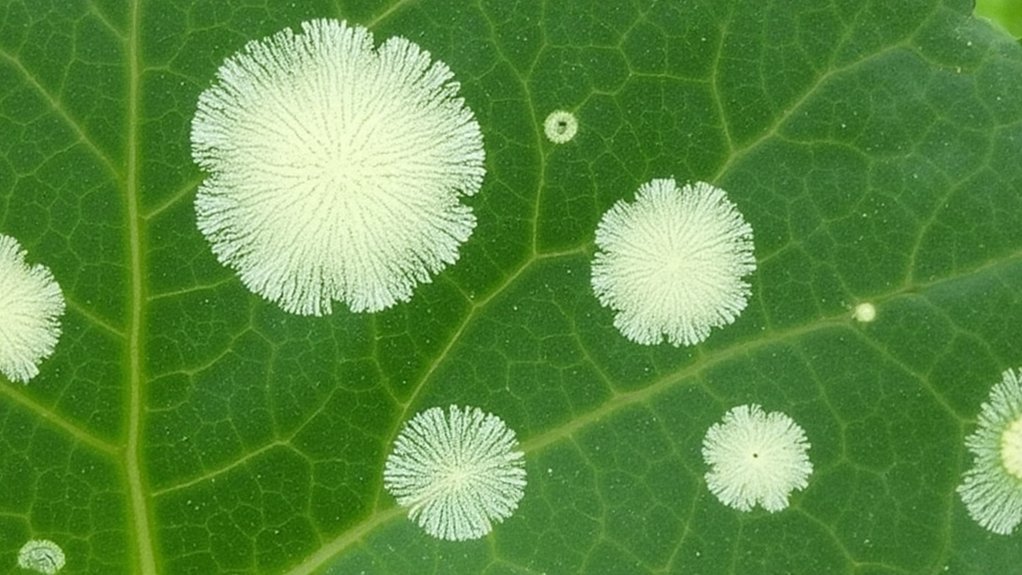
Although it can sneak up on you, identifying powdery mildew on your plants is pretty straightforward if you know what to look for. Check your plants regularly, especially during humid spells. Look for subtle signs on leaves, stems, and buds.
Start by inspecting the upper and lower leaf surfaces for unusual changes. You’ll often notice small, circular spots or patches, about 1/8 inch wide, that might spread if ignored. These can appear on roses, cucumbers, or squash within days of humid weather.
Don’t wait for it to worsen; catch it early. Examine plants every 3-4 days, especially in summer. If you spot those telltale marks, act fast. Keep a close eye, and you’ll stay ahead of this sneaky issue.
White Fungal Coating
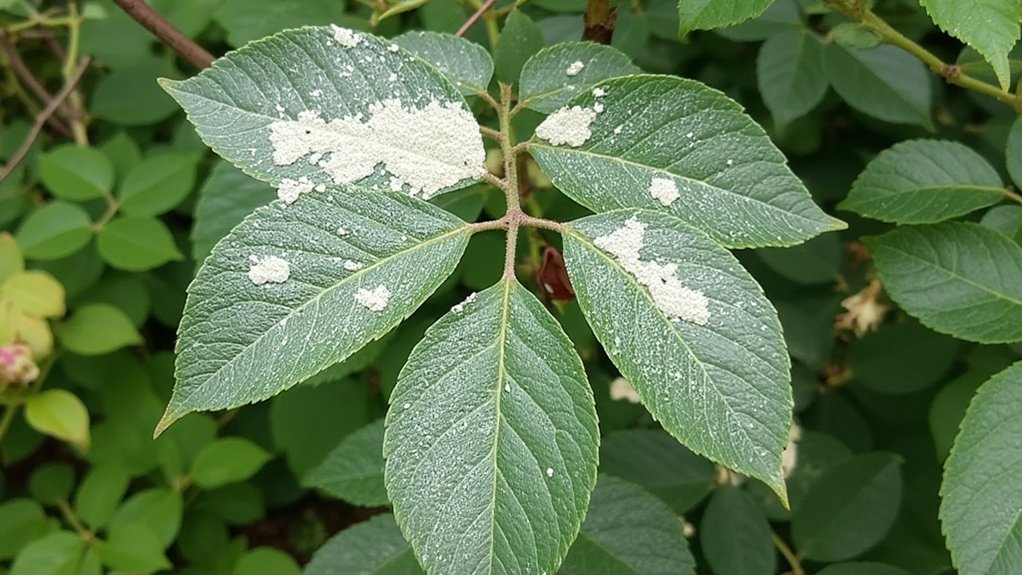
While you’re scanning your plants for issues, you’ll likely spot powdery mildew’s signature white fungal coating. It’s a sneaky problem, often dusting leaves with a fine, flour-like layer. Don’t ignore it, or it’ll weaken your plants fast.
Check the upper and lower leaf surfaces, especially on roses, cucumbers, or squash. You’ll see this coating spread in humid, crowded conditions, often when air circulation’s poor. It thrives in temperatures between 60-80°F, so watch out during mild weather.
Act quickly if you spot it—remove affected leaves with scissors, bagging them to avoid spores. Then, improve airflow by spacing plants at least 12 inches apart. Apply a fungicide, following label instructions, within 48 hours. You’ve got this, just stay vigilant!
Visible White Patches
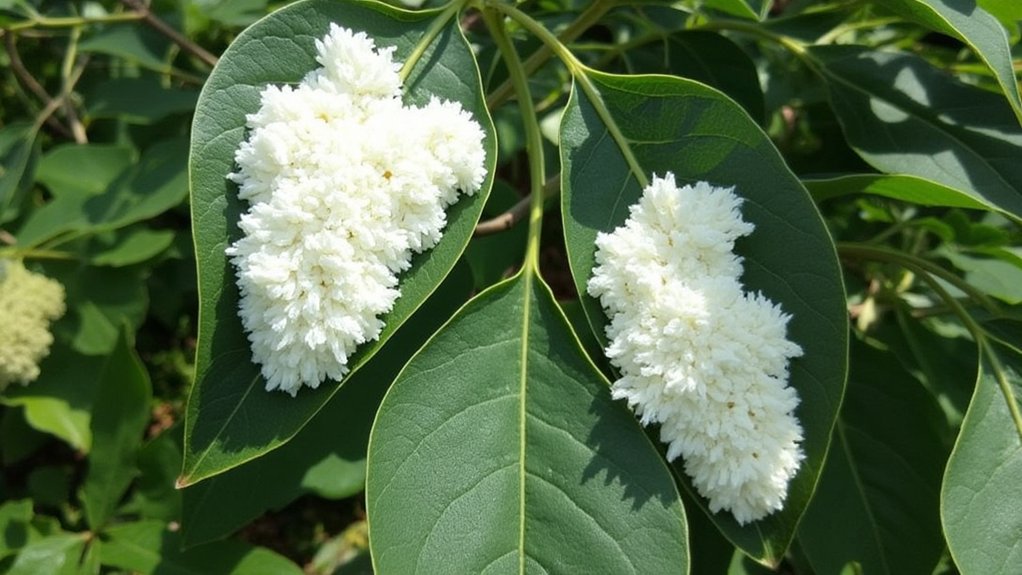
Spotting visible white patches on your plants can signal a different issue from powdery mildew. These patches might indicate a fungal infection like white mold, often found on stems or leaves. Check closely; if you see fluffy, cotton-like growth, especially in damp conditions, that’s a clue.
Now, act fast to stop the spread. Cut off affected parts with clean shears, making sure to disinfect them after each snip. Dispose of the clippings in a sealed bag, not your compost, to avoid contamination. Then, improve air circulation around your plants by spacing them at least 12 inches apart.
Lastly, apply a fungicide labeled for white mold, following the instructions. Reapply every 7-10 days until the patches disappear. Keep monitoring!
Distinctive Powdery Residue

Hey, let’s shift focus a bit from those white patches to another common issue you might notice on your plants. It’s that distinctive powdery residue, often a sign of powdery mildew. You’ll spot this grayish-white dust on leaves, stems, or even buds.
Look closely, and you’ll see it spreading if unchecked, especially in humid spots. Check your plants daily, focusing on shaded areas where air doesn’t circulate well. If you find this residue, act fast—remove affected leaves with scissors, and dispose of them in a sealed bag.
Next, treat the plant with a fungicide spray, following the label for exact mixing ratios, often 1 tablespoon per gallon of water. Apply it every 7-10 days until the powder’s gone. Keep monitoring!
Yellowing Leaf Edges
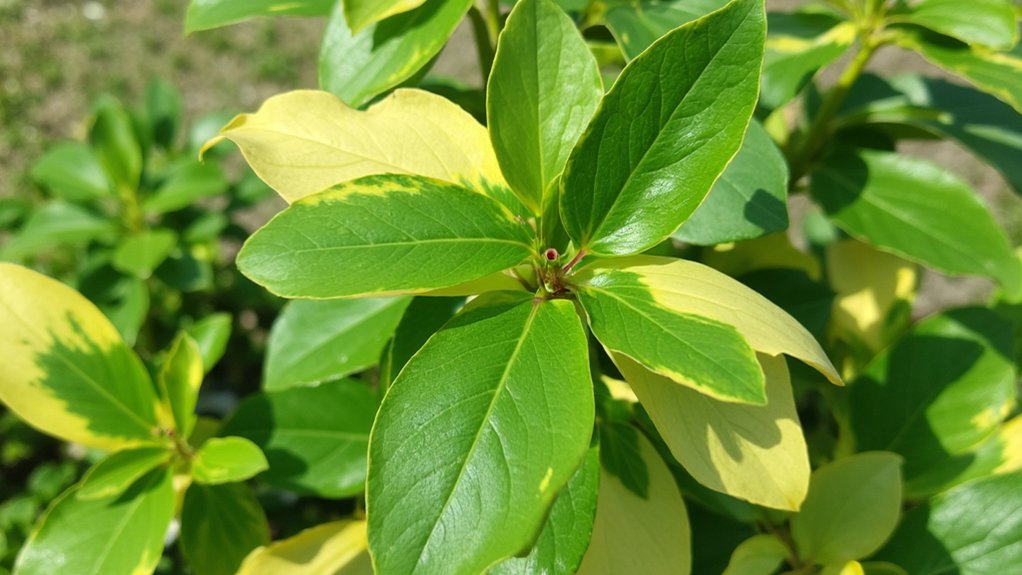
As you inspect your plants, you might notice the edges of their leaves turning yellow, a sneaky little warning sign. This often points to nutrient deficiencies, like a lack of potassium or magnesium. Don’t ignore it; it’s a cry for help!
Check the soil first, since poor drainage can cause this issue. Grab a soil test kit from your local garden center, and test for pH levels—aim for 6.0 to 7.0. If it’s off, adjust with lime or sulfur, following package directions.
Next, look at your watering habits. Overwatering can stress roots, so make sure you’re giving just 1 inch per week, depending on weather. Finally, apply a balanced fertilizer, like a 10-10-10 mix, every 4-6 weeks to replenish nutrients. Keep watching those leaves!
Stunted Plant Growth
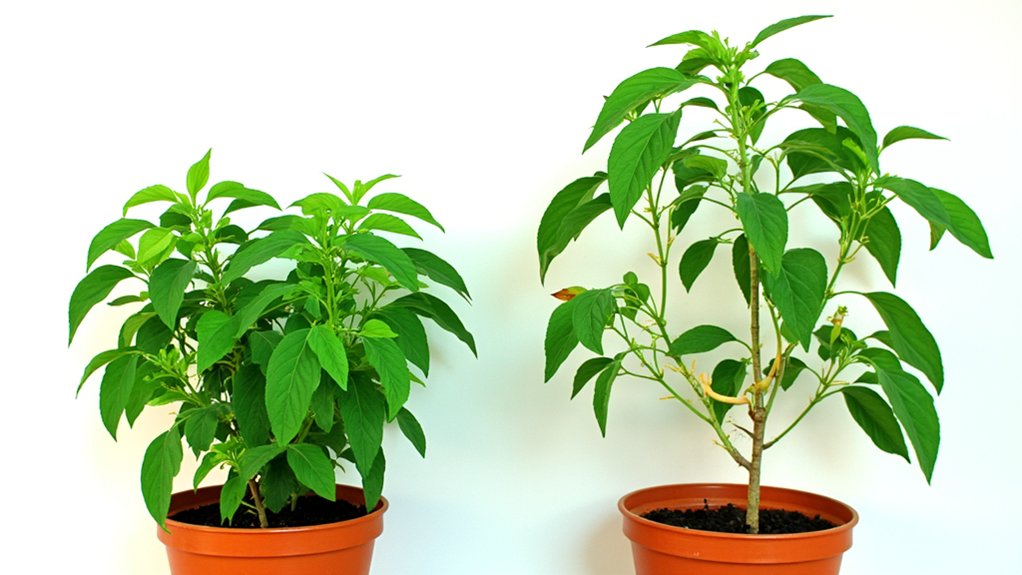
Notice how some of your plants just aren’t growing as they should? You’ve watered them, fed them, yet they’re barely inching up. Stunted growth often signals a hidden disease, like root rot or nutrient deficiency. Let’s figure this out together.
First, check the soil’s moisture with your finger, about 2 inches deep. If it’s soggy for days, you’re overwatering, and roots can’t breathe. Cut back to watering only when the top inch dries out, roughly every 5-7 days. Next, inspect for tiny pests or fungal spots on stems.
If you spot anything odd, isolate that plant fast—don’t let trouble spread. Use a fungicide, following label directions, applying every 10 days until growth resumes. Keep watching closely, alright?
Distorted Leaf Shapes
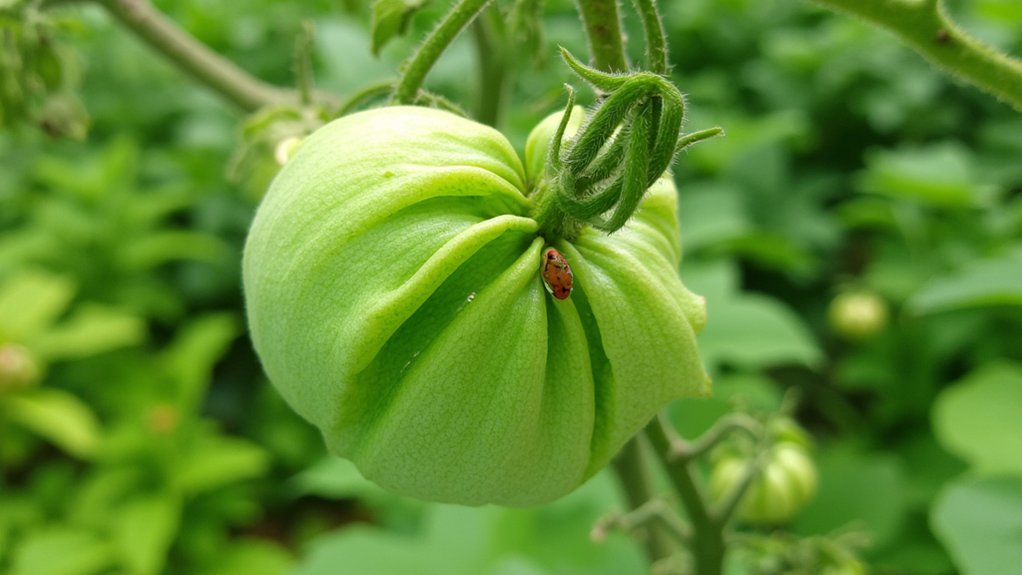
Ever spotted leaves on your plants that look twisted or oddly curled? If so, you’re likely dealing with distorted leaf shapes, a common sign of plant distress. This could stem from pests, viruses, or even herbicide exposure.
Start by inspecting your plant closely, especially under the leaves, for tiny pests like aphids, which are often 1-2 millimeters long. If you spot them, rinse the leaves with a strong stream of water daily for a week. Next, check for viral symptoms—leaves might show uneven, puckered edges or weird bumps. Unfortunately, there’s no cure for viruses; you’ve gotta remove and discard affected plants immediately to stop the spread. Act fast, and don’t let these issues sneak up on your garden!
Fuzzy White Growth
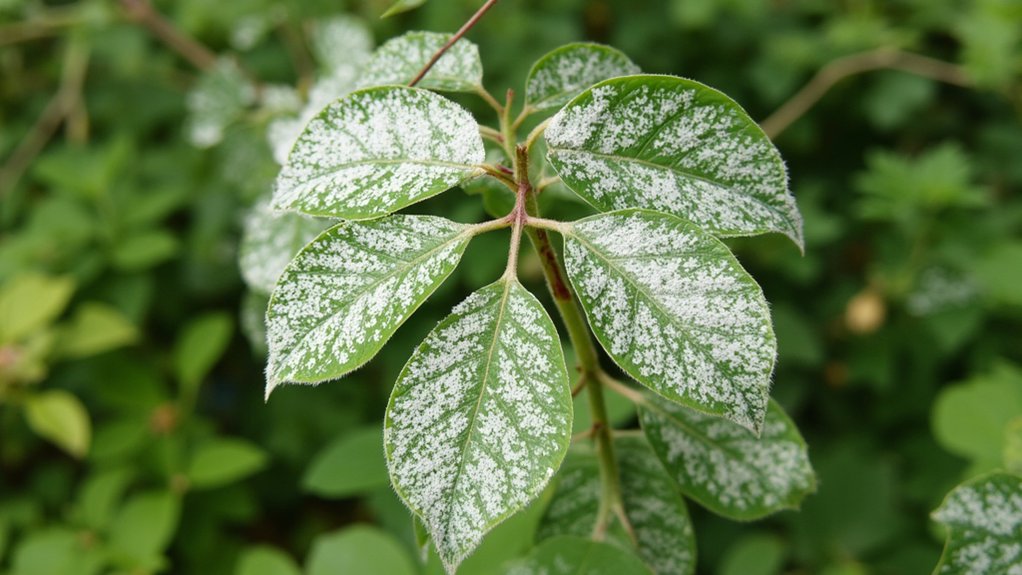
Spotting a fuzzy white growth on your plants can be a real head-scratcher, but don’t worry, I’ve got you covered. This is likely powdery mildew, a common fungal issue. It shows up as a white, fuzzy coating, often on leaves or stems.
Check the tops and undersides of leaves for this growth; it spreads fast if ignored. You’ll notice it more in humid, crowded conditions, especially if air circulation is poor. Act quickly to stop it.
Start by pruning affected areas—cut off infected leaves with clean shears. Then, mix a solution of 1 tablespoon baking soda, 1 teaspoon dish soap, and 1 gallon of water. Spray it on every 7 days until the fuzz disappears. Keep plants spaced for better airflow, too.
Characteristic Musty Odor
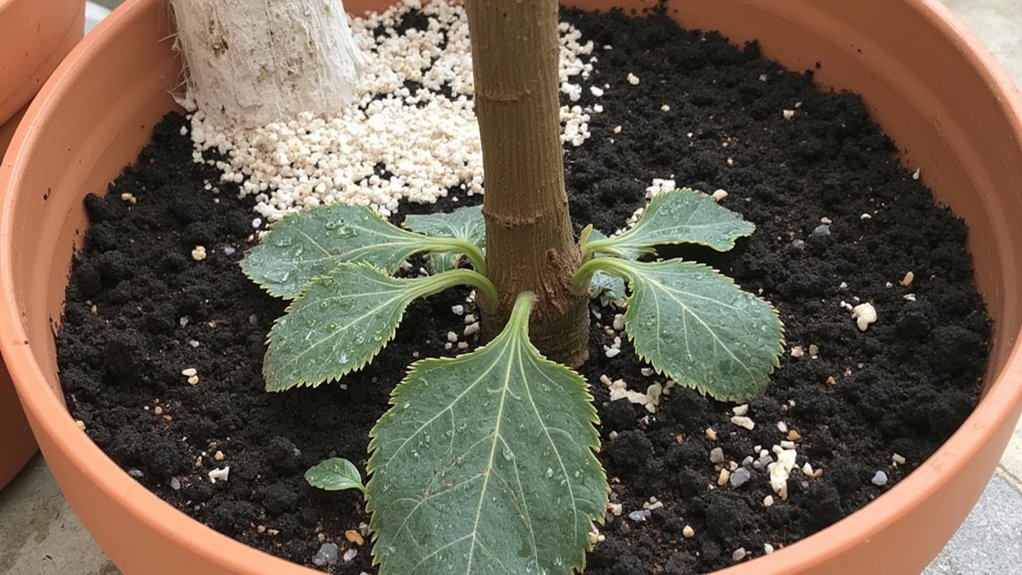
Got a whiff of something funky coming from your plants? That characteristic musty odor often signals a problem, like root rot or mold. Don’t ignore it; it’s a red flag screaming for attention.
Sniff around the base of your plant, especially near the soil. If the smell’s stronger there, you’ve likely got excess moisture causing decay. Check the pot’s drainage holes—are they clogged? Clear them out immediately to prevent water buildup.
Next, inspect the soil’s top layer for any grayish fuzz or slime, common with fungal issues. If you spot it, scrape off the top 1-2 inches, then let the soil dry out for 3-5 days. Finally, water sparingly, only when the top inch feels dry. Act fast, and you’ll save your green buddy!
Noticeable Leaf Curling
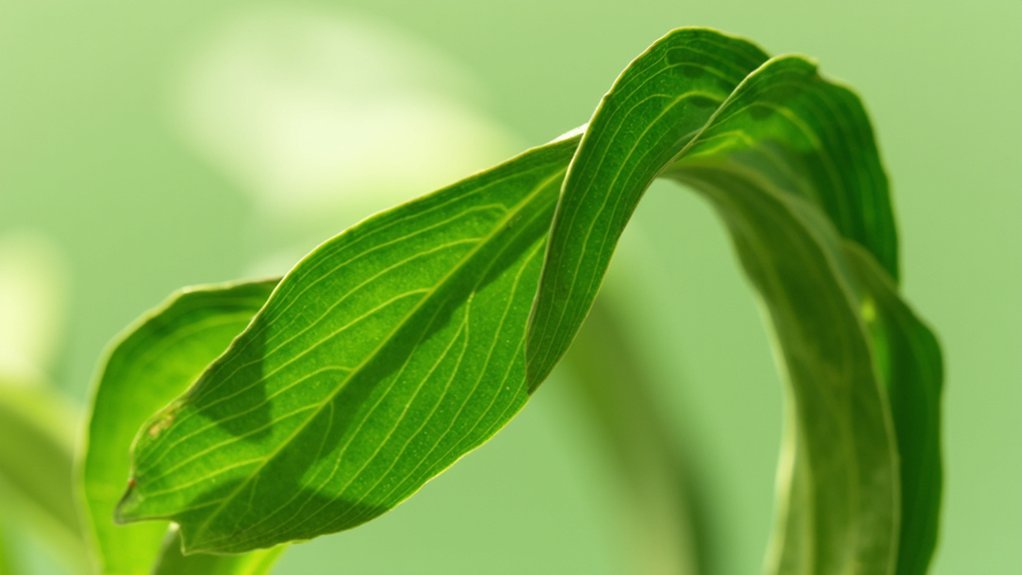
Take a close look at your plant’s leaves—are they curling up or down? If you’re seeing this, it might signal stress, pests, or disease. Leaf curling isn’t just weird; it’s a cry for help.
First, check for tiny pests like aphids or spider mites under the leaves. Use a magnifying glass if needed, as these critters are often smaller than 1 millimeter. If you spot them, spray with insecticidal soap, covering every inch.
Next, consider watering—curling downward often means overwatering, while upward curling hints at thirst. Adjust to a schedule of watering only when the top 1 inch of soil feels dry. Finally, inspect for viral infections; if leaves yellow alongside curling, isolate the plant fast to stop spread.
